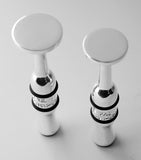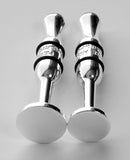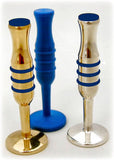P.E.T.E. - Personal Embouchure Training Exerciser
Scroll down for Instructions
The P.E.T.E. is a unique tool to use to perform isometric exercises that strengthen and develop the embouchure. The P.E.T.E. is the only tool on the market that exercises the exact musculature involved in playing wind instruments. Regular use of the P.E.T.E. will result in increased endurance and flexibility, and for many players, increased range.
The P.E.T.E. PRO is an advanced-level isometric strengthening tool to be used by experienced altissimo players. It is important that users have well-developed embouchure strength and/or previous experience with the P.E.T.E. for Brass before using this model. Players who are required to regularly play in the extreme upper register, or those who have reached a plateau in their efforts with the original P.E.T.E. will find that the P.E.T.E. PRO provides them with the additional challenge they’re looking for. We have researched the effectiveness of this new developmental tool by sending it out to select professional players, and have received enthusiastic reports.

The P.E.T.E PRO disk is about 5/8" in diameter, compared to the approximately 3/4" disk of the P.E.T.E. for Brass. The P.E.T.E. PRO is machined from brass and available in silver or gold plate.
P.E.T.E. Provides Efficient and Effective Embouchure Conditioning For
Trumpet - Trombone - Tuba - French Horn - Any Brass Instrument Player!
and
Flute - Saxophone - Clarinet - Oboe - Bassoon - Any Woodwind Instrument Player!
Brass and Woodwind playing is an art and a skill. It is also a physical activity which requires not only breath control, but a steadfast embouchure that will not break down before the end of a performance.
Professional Quarterbacks throw the football great distances with accuracy. They do this by practicing their skills on the field. What we don’t see is the time spent in the gym preparing the muscle groups needed so that they can practice these skills. Engaging in either one of these activities in excess is less effective than doing both in balance.
Use P.E.T.E. as an adjunct tool to assist you in becoming a better player!
P.E.T.E. for Woodwind instrument players!
Very soon after the release of our P.E.T.E. for brass players, we started getting positive feedback from woodwind players who were trying it out. While the brass player's model was indeed helping them with embouchure development, we worked with numerous woodwind players to discover that a design change to our original model would better target the embouchure muscles used by woodwind players.
Reed players will gain muscle strength needed to better control the reed - resulting in improved intonation in the extreme upper and lower registers. The tendency of palm key notes to go sharp and bottom notes to go flat will be greatly reduced or completely eliminated!
Available in the same materials as the brass player's model - except that the plastic model is blue Delrin plastic instead of black.
FAQ
The main difference is weight - The plastic model is much lighter than the plated brass models. The extra weight of the silver/gold version, for most people, enhances the workout when supporting the small end of it in your chops. On the other hand, many people simply prefer the look of the silver or gold models - and in fact - silver is the most popular model. The plastic and gold models also appeal to players with an allergy to silver.
What time of day should I use the P.E.T.E.?
Time of day to use the P.E.T.E. depends on your individual practice and playing schedule. There are several things to consider:
- Your muscles need time to recover from the exercise in order to gain strength and endurance from the conditioning process.
- You should avoid the regular exercises using the P.E.T.E. for a period of time before practicing or performing. Note that many players find that a very gentle and short exercise before playing actually helps with their warm-up.
- Best results will come from establishing and following a regular exercise routine.
Just as with any other exercise program, your developing embouchure muscles need time to recover after exercising to ensure that the muscles are ready for practice or a performance. Depending on your level of conditioning, the recovery time before playing for most P.E.T.E. users varies between 2 hours and 48 hours. Someone with well conditioned and developed embouchure muscles may be comfortable playing within a couple hours after a moderate to aggressive level of muscle workout. Someone just starting out with the P.E.T.E. probably needs more resting time before they feel ready to play.
Each player is different in this regard. The important thing to remember is: Don't try to do too much too soon!
How long should the P.E.T.E. exercise session last, and how aggressively can I use it?
First time P.E.T.E. users should limit the length of time for the exercises (described in the inscructions) to 2 or 3 repetitions of each exercise lasting somewhere between 15 seconds and 45 seconds each. This may not sound like much of a workout to begin with - however many new users users discover noticeable results within the first couple days of P.E.T.E. usage.
In the instructions we describe Exercise #1 as a "tug of war" between using your embouchure muscles to hold the P.E.T.E. in place while pulling it in the opposite direction. The harder you try to hold it in place, the harder you can try to pull. Start out gently with this - such that you are starting to feel the muscles get tired and lose grip on the P.E.T.E. after 15 to 30 seconds.
Then stop using it and let the resting, recovery, and conditioning process take place.
After using the P.E.T.E. for several months, many users report being able to perform each exercise for several minutes - and of course, with that level of conditioning, they also report that their endurance, control, and power has also increased very substantially.
The P.E.T.E. is effective as an isometric strengthening tool. Do not attempt to adapt the P.E.T.E. for motion (bulk building) exercises as results may be counterproductive. For trumpet players wanting a complementary isotonic workout, use the Warburton Advanced Training Visualizer (A.T.V.) with the same rim size as your trumpet mouthpiece.
The keys to success using the P.E.T.E. are simple:- Pace yourself - You can't get 6 weeks worth of results from 6 days of training - however it is very likely that you WILL notice improvements within the first week of use.
- If it feels like you're overdoing it, then you need to back off a little and let the rebuilding and conditioning process happen.
- Stick with it - Even after you've been using it for 6 months and your chops are strong enough to endure the most challenging performance, you should still use it enough to maintain that high level of conditioning.
With our introduction of the new A.T.V. (Advanced Training Visualizer), we need to better explain the differences between ISOMETRIC and ISOTONIC muscle building exercises.
The following is an excerpt from a longer article written about the P.E.T.E. by our good friend and dealer in Japan, Taijiro Takeura:
Generally speaking, there are two methods for training your muscles: isotonic exercises and isometric exercises.
Isotonic training (a.k.a. dynamic training) involves repeating a fixed set of movements while placing strains on a particular muscle, for example by using weights. In isometric training (a.k.a. static training), on the other hand, you strengthen a particular muscle by exerting a fixed amount of force over a certain period of time.
Both training methods have their advantages and shortcomings.
Isotonic training is very effective at training large muscles and easy to understand. It's also easy for the trainee to notice its effects. At most gyms that cater to the general public, muscle training is based on isotonic training methods. Its drawback, however, is that you can injure yourself if you choose the wrong parameters-- for example, by lifting weights that are too heavy for you, or by training for too long a time.
Isometric training is based on the theory that you can most effectively train your muscles by exerting about 60-70% of your maximum strength and holding still for about ten seconds. The most widely known isometric exercise, perhaps, is to press your palms together in front of your chest and hold still. Your muscles will always be working within their limits, so you can't injure yourself this way. You can also use isometric training to strengthen smaller muscles which may be difficult to train isotonically. On the other hand, the effects of isometric training are never as spectacular as those of isotonic training, which leads some people to overwork themselves; it can also be difficult to maintain your motivation when the results are difficult to see. In order to effectively train yourself using isometric methods, you do need a certain amount of knowledge. Isometric training can be seen in some of the more advanced gyms, especially those that cater to professional athletes.
Now let's see how all of this relates to brass playing.
Practicing on your instrument, including routines (such as long tones and scales) and etudes, consists of articulating various notes repeatedly, where the force of the air varies according to the height of the note, volume, etc. This can be thought of as a type of isotonic training. By going through the routines and etudes (which hopefully has been chosen to match your level of expertise) in a consistent manner, you can expect to significantly improve your playing. The visible improvement will give you great satisfaction. On the other hand, if you become impatient and tackle advanced materials too early, you can cause your muscles to degrade; caution is required.
Practicing using the P.E.T.E. is a type of isometric training; you exert a certain amount of force and hold still for a certain amount of time. It's possible to isolate and strengthen just those muscles that work in the way (explained above) that is unique to the embouchure. You can also strengthen the muscles that surround and support the embouchure. There isn't much chance of injuring your muscles, because you should be able to keep the strain on your muscles within bounds; you should, however, still be watchful. You should also note that isometric training using the P.E.T.E. can't improve all aspects of brass playing. You still have to use your instrument to practice the techniques that involve the air stream.
_____________________________________________
For Detailed Instructions Click Here
_____________________________________________
"Placing the disk behind the lips and pulling the exerciser forward prompts an isometric response from the muscles of the lips, preparing them for the forces encountered in brass playing"

"The P.E.T.E. directly targets the exact muscles that tire toward the end of a performance. These are the muscles which prevent the lips from falling into the cup, blowing apart, and losing the buzz."
_____________________________________________

"Warburton invented that great tool. It sets up the embouchure beautifully.
If you ever need to see the proper embouchure, there it is."
- Doc Severinsen talking about the P.E.T.E. at the 2015 ITG conference in Columbus, Ohio.
Here's what others are saying about the P.E.T.E.








